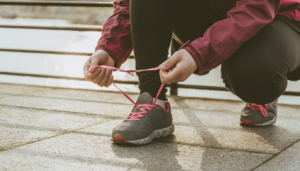
By Isabelle Zendler
Have you ever thought about changing the way you tie your laces to suit your feet? We know right… what?!
More often than not we like to overcomplicate things but something as simple as changing the way you lace your shoes could go a long way when it comes to reducing foot pain. There are a number of different lacing techniques that we can use to suit the needs of different foot types. After all, all feet are unique so why would one lacing technique suit all?
1. High arch lacing:
This high arch lacing technique opens up the middle section of the lace pattern and reduces pain and discomfort across the top of the foot. People with high arches who often experience pain in this region will find great benefits from this style of lacing. This technique would also be useful for those with exostosis, which is the formation of a new bone on the surface of an existing bone as well as people who suffer from oedema which is a condition where an excess of watery fluid collecting in the cavities or tissue in your body.
Steps to perfecting the high arch lace:
- Criss-cross the laces through the first set of lace holes.
- At the next set of holes thread the laces along the sides.
- Continue to thread the laces in criss-cross style to the top of the shoe and tie up laces.

2. Heel-lock lacing
This method of lacing can be of great benefit for those suffering from Achilles problems as the looping pattern of the laces locks the ankle in position, providing stability and support. This will help prevent irritation and the heel slipping at the back of the shoe.
Steps to nail the heel-lock lace:
- Thread the laces in criss-cross style all the way until the second to last set of holes.
- Thread the laces through the last hole along the sides of the shoes without crisscrossing.
- Finally, loop the laces through the hoop made at the second last hole and tie up the laces.

3. Wide foot lacing:
This lacing technique is used for people with a wide forefoot which is having wider feet or abnormalities such as bunions. People with wide feet may experience pressure and pain along the top and sides on the toe box (the section of footwear that surrounds the toes on closed-toe shoes). This lacing technique will help by loosening up the shoe and creating more space alleviating pressure from these areas.
Steps to achieving ideal lacing for wide feet:
- Thread the laces in criss-cross style in the first set of lace holes.
- Continue crisscrossing the laces, skipping every second lot of lace holes until you reach the top of the shoes and then tie up the laces.

4. Narrow foot lacing:
Like those with structurally wide feet we also get people with structurally narrow feet. Sometimes people with narrow feet can find it difficult to get their shoes tight enough and this can cause the foot to slip out of the shoes leading to discomfort when wearing them.
By skipping a set of shoelace holes when lacing, this can help to tighten up the shoes and result in feet being more supported and prevent them from slipping out of the shoes.
Steps to achieve the perfect:
- Begin with lacing in a criss-cross pattern
- Skip a set of shoelace holes and continue the criss-cross pattern to the top of the shoes and tie the laces.

